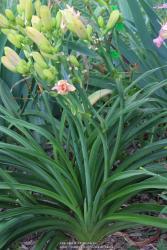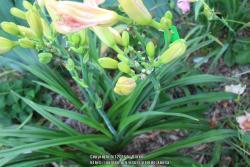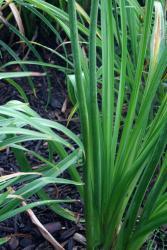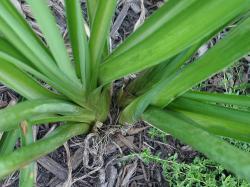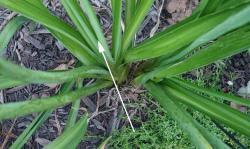@seedfork
By definition a fan always produces only one scape.
A daylily crown is a compressed shoot or a compressed stem.
Many plants have a simple growth pattern. They produce a stem with leaves on alternate sides. As the plant grows the stem increases in height and more leaves are produced.
When plants have this simple growth pattern there is often a main bud at the very top of the stem. To get the plant to be bushy, the gardener may "pinch out" or cut-off the tip of the stem including the bud. When that is done, buds on the stem between a leaf and the stem may start to grow branches and the plant becomes bushy. Those buds are called axillary buds because they are formed in the angle made by the leaf and the stem.
A daylily has the same simple growth pattern but its stem (or shoot) more or less does not visibly grow (taller). That stem/shoot is called the daylily crown. The part that produces the new daylily growth, the equivalent to the main bud of many plants is called the growing point or the shoot apical meristem (SAM for short).
The job of the SAM is to produce new leaves and a tiny section of new stem or shoot (crown tissue). The SAM produces what we call the fan. It does that while the fan is juvenile or not mature (it cannot flower yet). The immature fan is described as vegetative. The SAM produces its new leaves and crown repeatedly. When the fan (or the crown or the SAM - we do not know which is the important factor) becomes large enough the SAM stops doing its vegetative job of producing new leaves and pieces of crown and becomes reproductive. The SAM does not simply produce the scape - it becomes the scape. It gets completely used up by the time the last bud is finished blooming. The fan no longer has a SAM. It cannot produce any more new leaves or crown tissue.
The crown (stem or shoot) does exactly what the stems of other plants do when they no longer have a bud (for example when it is pinched out). It produces one or more new SAMs in the angles between a leaf and the crown.
The new SAM produces a new fan of new leaves.
So by definition a scape is the last thing a SAM does. A new SAM then needs to be created.
The catch.
Some daylily cultivars, in some growing conditions produce a new SAM and it starts to produce new leaves before the scape is large enough for the gardener to notice. These are called continuous growers and it is often next to impossible to distinguish the a new SAM and a new fan have been created.
Other daylily cultivars in other growing conditions do not produce a new SAM quickly. The scape may become visible to the gardener before any new leaves are produced by the new SAM and those leaves are noticeably different from the leave sof the previous fan. They are smaller. These are called discontinuous growers.
